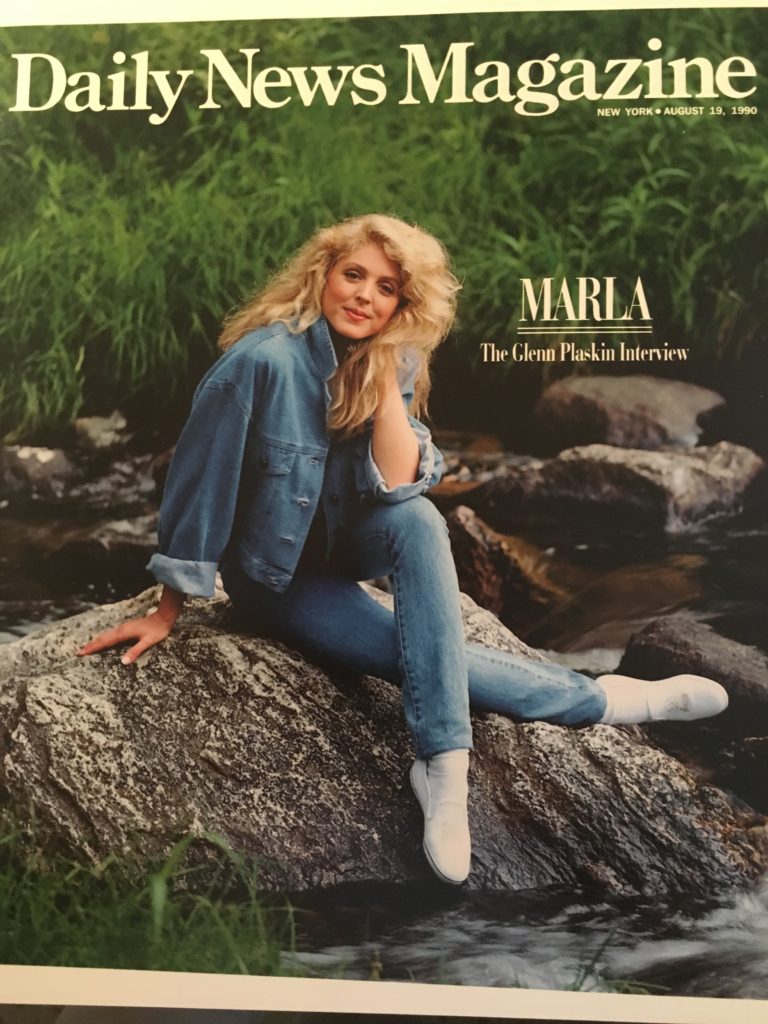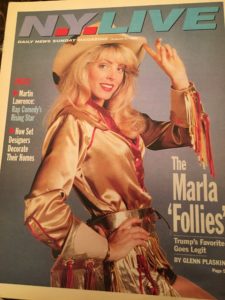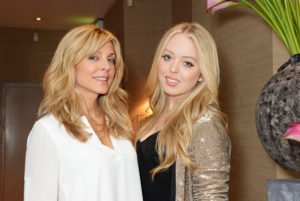On a warm spring day in Manhattan, the doorman in my Battery Park City apartment building rang me up on the intercom phone to announce a very unusual guest.
“Glenn,” said Felipe, sounding taken aback, “Marla Maples is here!”
“Send her up,” I said, anticipating my famous visitor.
 And so began a very private interview, given by Maples during the Donald-Ivana-Marla tabloid triangle, a spectacle that was then rocking New York.
And so began a very private interview, given by Maples during the Donald-Ivana-Marla tabloid triangle, a spectacle that was then rocking New York.
Because Marla was the biggest news media draw in America in 1990, she would have been mobbed by paparazzi had we conducted the interview anywhere else, so my apartment was the unexpected choice for an exclusive sit-down, the chance for her to talk thoughtfully about her new-found notoriety.
As a magazine reporter at the New York Daily News, I felt fortunate to have gotten the interview at all, which happened thanks to Donald Trump’s recommendation, since I had months earlier interviewed him for the News.
 And it wouldn’t be long before I’d interview him for the cover of Playboy Magazine.
And it wouldn’t be long before I’d interview him for the cover of Playboy Magazine. 
During the wide-ranging 2-hour chat, Marla, the most unflappable, articulate 24-year-old, spoke eloquently about her relationship with The Donald, and maturely faced down the judgments of those who criticized her:
 “What I’ve learned,” she mused, “is that nothing is black and white. Sometimes, our biggest fears and hypocrisies come back to haunt us—to teach us lessons. I absolutely believe that my higher power put this in my path—so that I would learn not to judge, just to love.”
“What I’ve learned,” she mused, “is that nothing is black and white. Sometimes, our biggest fears and hypocrisies come back to haunt us—to teach us lessons. I absolutely believe that my higher power put this in my path—so that I would learn not to judge, just to love.”
At one point during the conversation, she got up and went into my bedroom, closed the door, and called Donald on a break.
If all this seems surreal now, back then, who could have ever guessed that Donald Trump would one day become President?
A few years later, Marla, of course, would marry Trump at the Plaza Hotel and have a daughter with him, Tiffany Trump, though that union would eventually end, with Marla moving to California as she pursued a career as an actress.
 In fact, two years after my first interview with Marla, she made her impressive Broadway debut as the star of the Will Rogers Follies, which yielded another cover story interview with her.
In fact, two years after my first interview with Marla, she made her impressive Broadway debut as the star of the Will Rogers Follies, which yielded another cover story interview with her.
As she laughed: “The last thing I wanted to do was get up and play what could have been looked at as a light blond role; but I watched it and saw it was a demanding, comedic part. And, finally, after all the time and money I’ve spent on getting rid of my Southern accent, now I can use it!”
Just a few months after this interview she kindly agreed to appear with me on The Oprah Winfrey Show in October 1992, to promote my book, Turning Point: Pivotal Moments In The Lives Of America’s Celebrities. She certainly had a pivotal moment to discuss! 
And on the show, which also included Angie Dickinson, Rod Steiger, and Annette Funicello, she spoke in very frank terms about her relationship with Donald Trump.
And now, decades later, Marla, at 55, is still startlingly youthful, proven by her appearance on Dancing With The Stars, where she displayed a physical grace that defies any age.
As for me, I can still see her sitting on the white couch in my living room, talking quietly about her hopes for a happy future, one that she has certainly achieved on her own terms—as a dedicated mother with a college-age daughter, and a multi-talented woman who has found her center.
With more than 15 films roles (Happiness, Black and White, Executive Decision), numerous TV appearances (Liv and Maddie, Spin City, The Nanny), Broadway shows (The Will Rogers Follies, Love, Loss and What I Wore), and dozens of magazine covers on her resume, Maples firmly secured her place in popular culture.
Nowadays, in her various pursuits, the actress, singer, social activist advocates both physical and spiritual health, with fantastic recipes on her web site describing a diet that has kept her happy and healthy.
Her charitable devotion is legion: Having contracted Lyme Disease as a teen, Marla has been honored for her work with the Global Lyme Alliance. In addition, she remains committed to supporting a multitude of non-profit organizations including AWARENYC.org, Spirituality for Kids, The Louis Armstrong Center for Music and Medicine, The City Of Hope, and Kids Creating Peace. Through it all, she maintains a dignity and resilience that have become her trademarks.
As she said in a recent interview: “I think life is about being ready for anything, and where are you going to find the positive in all things,” she said. “I choose not to judge anybody else. I don’t want to be judged, so how can I judge another human being? I say to my friends, let’s help lift this world, not bring it down.”

LONDON, ENGLAND – JULY 28: Marla Maples (L) and Tiffany Trump have dinner at Sumosan on July 28, 2014 in London, England. (Photo by David M. Benett/Getty Images)






